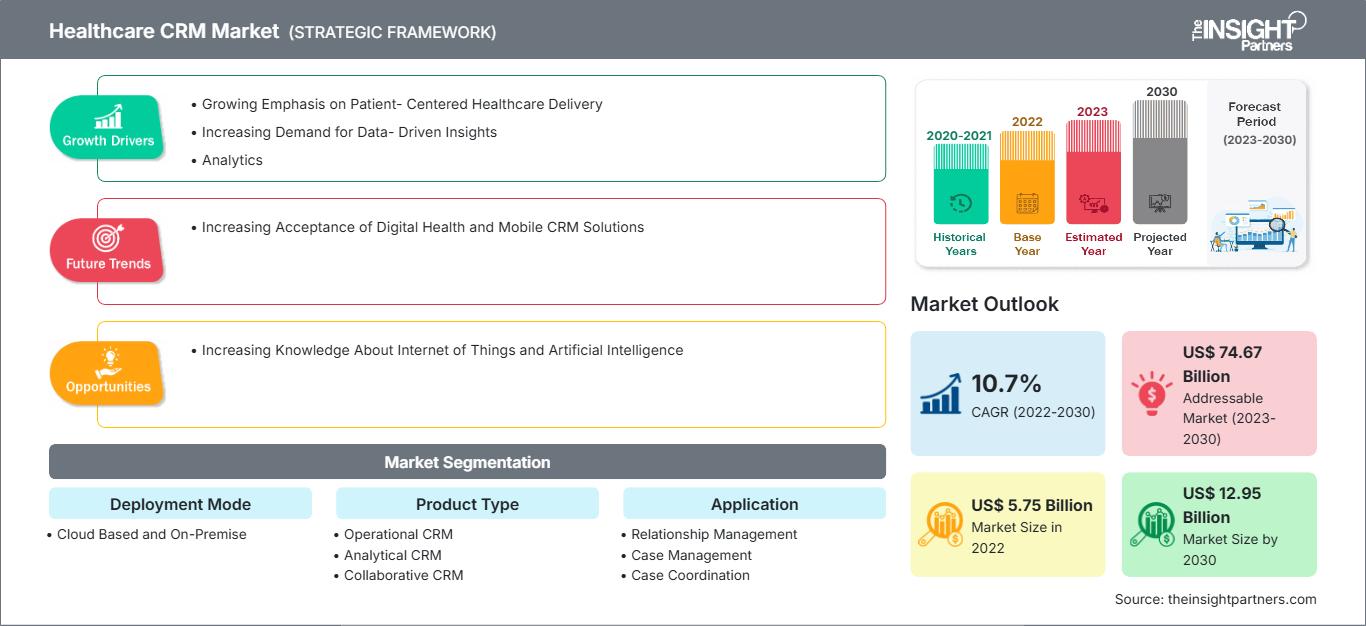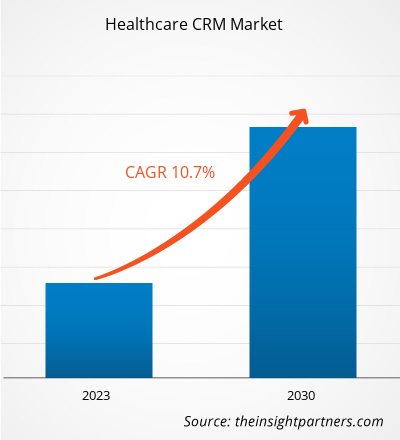[연구 보고서] 헬스케어 CRM 시장 규모는 2022년 57억 5,095만 달러에서 2030년 129억 4,715만 달러로 성장할 것으로 예상되며, 2022년부터 2030년까지 연평균 성장률은 10.7%입니다.
시장 분석 및 분석가 의견:
헬스케어 CRM은 의료 서비스 제공업체가 환자 정보를 저장 및 관리하고, 서비스 및 참여를 개선하며, 환자 확보 전략을 개선하고, 의료 보안 기준을 준수하면서 마케팅 및 영업 운영을 자동화할 수 있도록 지원하는 산업별 시스템입니다. 헬스케어 CRM 시장 성장을 견인하는 주요 요인으로는 환자 중심 의료 서비스 제공에 대한 중요성 증가와 데이터 기반 인사이트, 분석 및 인구 건강 관리에 대한 수요 증가가 있습니다. 그러나 데이터 보안 부족과 환자 정보 프라이버시 관련 우려는 헬스케어 CRM 시장 성장을 저해하고 있습니다.
성장 동인과 제약:
의료 시스템에서 환자 중심적 접근 방식은 환자, 환자 가족, 그리고 의료진 간의 파트너십을 구축하여 환자의 필요, 선호도, 그리고 요구에 따라 의사 결정을 내릴 수 있도록 지원합니다. 또한 환자가 특정 결정을 내리고 치료에 참여할 수 있도록 구체적인 교육과 지원을 제공하는 것도 포함됩니다.
모든 이해관계자(의료 제공자, 환자 등)와의 소통 강화는 전반적인 비용을 절감합니다. 또한, 환자의 건강, 웰빙, 그리고 의료 선택에 대한 지식과 이해가 향상되면 치료가 향상되고 질병 발생률이 감소합니다. 이러한 지식 향상은 퇴원 후 치료, 병원 방문, 재입원 및 2차 진료 감소를 촉진할 수 있습니다. 의료 제공자는 환자와 함께 의사 결정에 참여하고 협력함으로써 환자의 건강에 대해 더욱 적절한 결정을 내릴 수 있습니다. 또한, 더 많은 병원들이 치료의 질과 비용을 기반으로 환자 유치 경쟁을 벌이게 되면서 경쟁 우위도 높아집니다. 환자의 삶의 질이 향상되면 의사와 환자 모두의 만족도가 높아집니다.
요구 사항에 맞게 이 보고서를 사용자 정의하십시오.
이 보고서의 일부, 국가 수준 분석, Excel 데이터 팩을 포함하여 모든 보고서에 대한 사용자 정의를 무료로 받을 수 있을 뿐만 아니라 스타트업 및 대학을 위한 훌륭한 제안 및 할인을 이용할 수 있습니다
헬스케어 CRM 시장: 전략적 통찰력

-
이 보고서의 주요 주요 시장 동향을 확인하세요.이 무료 샘플에는 시장 동향부터 추정 및 예측에 이르기까지 데이터 분석이 포함됩니다.
기술 혁신과 소프트웨어 개발은 의료 산업 혁명에 매우 중요합니다. 이러한 기술 발전은 의료 및 행정 서비스를 지원하여 의료 프로세스, 커뮤니케이션 및 워크플로를 획기적으로 개선하고 간소화합니다. 환자 중심 의료는 환자 만족도를 높여 의료 제공자와 의료 기관 모두에게 도움이 됩니다. 따라서 의료 제공자의 환자 중심 접근 방식 채택 증가는 의료 CRM 시장의 성장을 촉진하고 있습니다.
하지만 CRM 포털에 저장된 민감한 의료 데이터의 보호는 의료 제공자와 의료 서비스 제공자 모두에게 중요한 관심사입니다. CRM을 운영하는 최종 사용자가 개인 정보를 제3자에게 판매할 수 있기 때문에 환자는 자신의 생물학적 데이터를 포함한 개인 정보의 프라이버시에 대해 우려합니다. 또한 이러한 기기가 환자의 의료 청구 기록과 연결될 경우, 금융 데이터 유출 위험이 더 커질 수 있습니다. HIPAA 저널에 따르면 2009년부터 2022년까지 500건 이상의 의료 데이터 유출 사고가 HHS 시민권 사무국에 신고되었습니다. 이러한 침해로 인해 3억 8,226만 2,109건의 의료 기록이 노출되거나 불법적으로 공개되었습니다. 이는 미국 인구의 1.2배가 넘는 수치입니다. 2022년에는 500건 이상의 의료 기록에 대한 데이터 침해가 매일 평균 1.94건 보고되었습니다. 기술 기업들이 자사 서비스의 보안 강화에 점점 더 많은 투자를 하고 있음에도 불구하고, 소비자들은 의료 관련 활동을 위해 소프트웨어에만 전적으로 의존하기까지는 시간이 걸릴 것으로 예상됩니다. 따라서 데이터 보안 및 개인정보 보호 문제는 CRM 소프트웨어 도입을 제한하고 시장 성장을 저해하고 있습니다.
트렌드:
의료 분야에서 디지털 헬스케어 및 모바일 고객 관계 관리(CRM) 솔루션 도입이 증가하는 추세는 의료 CRM 환경을 변화시키고 있으며, 환자 참여, 가상 의료 서비스 제공, 모바일 진료 조정을 간소화하는 혁신적인 플랫폼에 대한 수요를 촉진하고 있습니다. 디지털 헬스에 대한 수용도가 높아짐에 따라 의료 산업은 디지털 채널, 모바일 기술, 향상된 환자 경험을 활용하여 진료 제공 및 환자 만족도를 최적화하는 데 더욱 적극적으로 기여하고 있습니다. 의료 인프라 내 디지털 헬스 도입은 다중 채널 진료 상호작용을 지원하고, 의료진과 환자 간 소통을 촉진하며, 다양한 접점에서 환자 참여를 강화하기 위해 진료 조정 도구, 안전한 메시징 플랫폼, 원격 진료 조정 기능을 통합하는 데 영향을 미칩니다. 또한, 모바일 기술 및 애플리케이션의 급속한 발전, 기존 eHealth 서비스에 모바일 헬스를 통합할 수 있는 새로운 기회, 그리고 모바일 셀룰러 네트워크 커버리지의 지속적인 확장은 모바일 CRM과 같은 모바일 헬스케어 솔루션의 확산을 뒷받침하는 주요 요인입니다. 국제전기통신연합(ITU)의 추산에 따르면 2020년 기준 무선 가입자 수는 50억 명이 넘으며, 그중 70% 이상이 저소득 및 중소득 국가에 거주하고 있습니다. GSM 협회에 따르면, 상업용 무선 통신은 전 세계 인구의 약 85%에 도달했으며, 이는 전력망의 도달 범위를 훨씬 넘어선 수준입니다. 무선 통신의 확산은 원격 환자 모니터링 및 진료 예약과 같은 문제 해결을 지원함으로써 진료의 질과 환자 건강을 향상시키고 매년 막대한 불필요한 의료비를 절감하는 데 도움이 될 것입니다. 모바일 헬스(mHealth)의 적용 분야는 향후 몇 년 안에 확대될 것으로 예상됩니다. Salesforce에 따르면, 병원의 약 52%가 세 가지 이상의 커넥티드 헬스 기술을 사용하고 있으며, 이 중 58%는 모바일에 최적화된 환자 포털을 사용하고 있습니다. 따라서 모바일 헬스 솔루션의 적용이 증가하고 전 세계적으로 디지털 헬스케어에 대한 수용이 증가함에 따라 다양한 의료 인프라에서 헬스케어 CRM에 대한 수요가 증가할 것입니다.
보고서 세분화 및 범위:
전 세계 헬스케어 CRM 시장은 배포 모드, 제품 유형, 애플리케이션 및 최종 사용자를 기준으로 세분화됩니다. 배포 모드에 따라 시장은 클라우드 기반과 온프레미스로 나뉩니다. 제품 유형에 따라 시장은 운영 CRM, 분석 CRM, 협업 CRM으로 구분됩니다. 헬스케어 CRM 시장은 애플리케이션별로 관계 관리, 사례 관리, 사례 조정, 지역 사회 지원 등으로 나뉩니다. 최종 사용자 측면에서 의료 CRM 시장은 공급자, 지불자 및 기타로 세분화됩니다. 지리적으로는 북미(미국, 캐나다, 멕시코), 유럽(독일, 프랑스, 이탈리아, 영국, 러시아 및 기타 유럽), 아시아 태평양(호주, 중국, 일본, 인도, 한국 및 기타 아시아 태평양), 중동 및 아프리카(남아프리카, 사우디아라비아, UAE 및 기타 중동 및 아프리카), 중남미(브라질, 아르헨티나 및 기타 중남미)로 세분화됩니다.
세분화 분석:
의료 CRM 시장은 배포 방식을 기준으로 클라우드 기반 및 온프레미스로 세분화됩니다. 클라우드 기반 부문은 2022년 시장 점유율이 더 높았으며, 2022년부터 2030년까지 더 높은 연평균 성장률(CAGR)을 기록할 것으로 예상됩니다. 클라우드 기반 의료 CRM 솔루션은 공급업체 서버에 호스팅되고 웹 브라우저를 통해 접속할 수 있습니다. 클라우드 기반 CRM 솔루션은 탁월한 접근성을 제공하여 의료 전문가가 인터넷 연결이 가능한 어느 위치에서나 환자 데이터와 CRM 도구에 접근할 수 있도록 합니다. 이러한 유연성은 특히 원격으로 또는 여러 위치에서 근무하는 의료 서비스 제공자에게 매우 유용합니다.
의료 CRM 시장은 제품 유형별로 분석 CRM, 협업 CRM, 운영 CRM으로 구분됩니다. 운영 CRM 부문은 2022년 시장 점유율이 가장 높았으며, 2022년부터 2030년까지 가장 높은 연평균 성장률을 기록할 것으로 예상됩니다. 운영 CRM은 의료 기관 내 진료 예약, 환자 등록, 청구, 청구 처리와 같은 운영 프로세스를 간소화하고 자동화하는 데 중점을 둡니다. 이러한 솔루션은 의료 서비스 제공자가 효율성을 개선하고, 관리 부담을 줄이며, 전반적인 환자 경험을 향상하는 데 도움을 줍니다.
의료 CRM 시장은 응용 분야별로 사례 관리, 관계 관리, 지역 사회 지원, 사례 조정 등으로 세분화됩니다. 관계 관리 부문은 2022년 시장 점유율 1위를 차지했으며, 2022년부터 2030년까지 가장 높은 연평균 성장률(CAGR)을 기록할 것으로 예상됩니다. 의료 CRM 시장의 관계 관리는 환자, 간병인 및 기타 이해관계자와의 강력한 관계 구축 및 유지에 중점을 둡니다.
최종 사용자 측면에서 의료 CRM 시장은 서비스 제공자, 지불자 및 기타 부문으로 세분화됩니다. 의료 서비스 제공자 부문은 2022년 시장 점유율이 가장 높았으며, 2022년부터 2030년까지 가장 높은 연평균 성장률(CAGR)을 기록할 것으로 예상됩니다. 병원, 진료소, 그리고 개별 의료 전문가를 포함한 의료 서비스 제공자는 환자 사례 관리, 진료 조율, 그리고 환자와의 강력한 관계 구축을 지원하는 CRM 솔루션이 필요합니다.
지역 분석:
지리적으로 의료 서비스 CRM 시장은 북미, 유럽, 아시아 태평양, 중남미, 그리고 중동 및 아프리카로 구분됩니다. 2022년에는 북미가 전 세계 의료 서비스 CRM 시장에서 가장 큰 점유율을 기록했습니다. 아시아 태평양 지역은 2022년부터 2030년까지 가장 높은 연평균 성장률을 기록할 것으로 예상됩니다.
미국 내 대부분의 병원과 진료소는 재정적, 운영적 어려움을 겪고 있습니다. 의료 CRM 소프트웨어는 주로 병원, 진료소, 외래 수술 센터와 연계되어 진료 예약 및 관리에 사용되며, 특히 응급실의 경우 외래, 입원, 수술실의 비효율적인 예약 관리에 활용됩니다. 효율적인 환자 예약 관리는 대부분의 병원과 진료소에서 여전히 시급한 과제입니다. 부적절한 진료 예약으로 인해 환자들은 공공 및 민간 의료 시스템에서 양질의 진료를 받지 못하는 경우가 많습니다. 2022년 의사 진료 예약 대기 시간 및 메디케어/메디케이드 수용률 조사에 따르면, 의사와의 첫 진료 예약까지 평균 26일이 소요되며, 이는 평균 대기 시간이 약 24일이었던 2017년 대비 8% 증가한 수치입니다. 이로 인해 대기 시간 연장, 진료 예약 어려움, 그리고 공공 및 민간 의료 부문의 수요와 공급 불균형이 발생합니다. 의료 CRM 소프트웨어를 통해 병원과 진료소는 환자의 진료 도착 및 출발 시간을 추적하고 본인 부담금 및 취소에 대한 실시간 업데이트를 받을 수 있습니다. 소프트웨어를 사용하면 예약 알림 전화를 통해 진료 불참률을 30%까지 줄일 수 있습니다. 이는 전체 치료 절차를 개선하고 환자와의 소통을 향상시킵니다.
또한 미국은 만성 및 급성 질환의 유병률이 높습니다. 미국 심장 협회의 "2023년 심장 질환 및 뇌졸중 통계"에 따르면, 2020년 미국에서 관상동맥 심장 질환(CHD)은 심혈관 질환 관련 사망의 주요 원인(41.2%)이었고, 그 뒤를 이어 뇌졸중(17.3%), 기타 심혈관 질환(16.8%), 고혈압(12.9%), 심부전(9.2%), 동맥 질환(2.6%) 순이었습니다. 미국 질병통제예방센터(CDC)에 따르면, 20세 이상 미국 성인 20명 중 약 1명이 관상동맥 질환을 앓고 있습니다. 따라서 심혈관 질환(CVD) 및 기타 만성 질환의 높은 유병률은 미국에서 진료 예약 및 헬스케어 CRM 도입에 대한 수요를 촉진합니다. 또한, 미국에서 헬스케어 IT 기술의 급속한 도입은 향후 헬스케어 CRM 시장 성장을 견인할 것으로 예상됩니다.
헬스케어 CRM 시장 지역별 통찰력
The Insight Partners의 분석가들은 예측 기간 동안 헬스케어 CRM 시장에 영향을 미치는 지역별 동향과 요인들을 면밀히 분석했습니다. 이 섹션에서는 북미, 유럽, 아시아 태평양, 중동 및 아프리카, 그리고 중남미 지역의 헬스케어 CRM 시장 세분화 및 지역별 현황도 살펴봅니다.
헬스케어 CRM 시장 보고서 범위
| 보고서 속성 | 세부 |
|---|---|
| 시장 규모 2022 | US$ 5.75 Billion |
| 시장규모별 2030 | US$ 12.95 Billion |
| 글로벌 CAGR (2022 - 2030) | 10.7% |
| 이전 데이터 | 2020-2021 |
| 예측 기간 | 2023-2030 |
| 다루는 세그먼트 |
By 배포 모드
|
| 포함된 지역 및 국가 |
북미
|
| 시장 선도 기업 및 주요 회사 프로필 |
|
헬스케어 CRM 시장 참여자 밀도: 비즈니스 역학에 미치는 영향 이해
헬스케어 CRM 시장은 소비자 선호도 변화, 기술 발전, 그리고 제품 이점에 대한 인식 제고 등의 요인으로 인한 최종 사용자 수요 증가에 힘입어 빠르게 성장하고 있습니다. 수요가 증가함에 따라 기업들은 제품 및 서비스를 확장하고, 소비자 니즈를 충족하기 위한 혁신을 추진하며, 새로운 트렌드를 적극 활용하고 있으며, 이는 시장 성장을 더욱 가속화하고 있습니다.

- 을 얻으세요 헬스케어 CRM 시장 주요 주요 플레이어 개요
글로벌 헬스케어 CRM 시장에서 활동하는 주요 기업들의 다양한 이니셔티브는 다음과 같습니다.
- 2023년 8월, IBM과 Salesforce는 전 세계 여러 산업 분야의 기업들이 CRM에 AI를 도입하는 것을 가속화하기 위한 협력을 발표했습니다. 양사는 협력을 통해 고객이 고객, 파트너, 그리고 직원 경험을 혁신하는 동시에 데이터를 보호할 수 있도록 지원합니다.
- 2022년 4월, Cured는 헬스케어를 위해 구축된 차세대 디지털 마케팅 및 고객 관계 관리(CRM) 플랫폼 출시를 발표하며, 이를 통해 의료 서비스의 완전한 순환(full-circle)이라는 사명을 더욱 효과적으로 달성할 수 있게 되었습니다. 이러한 플랫폼 발전을 통해 헬스케어 기관은 신규 고객 및 기존 환자와 탁월한 관계를 구축할 수 있습니다.
- 2021년 11월, Pegasystems Inc는 Google Cloud와 협력하여 더 나은 데이터 인사이트와 개인 맞춤화를 통해 헬스케어 경험을 개선했습니다. Pega와 Google Cloud의 이번 파트너십을 통해 Google Cloud의 Healthcare Data Engine과 Pega의 지능형 의료 솔루션 제품군의 역량이 통합되었습니다.
경쟁 환경 및 주요 기업:
Pegasystems Inc, Sage Group Plc, IQVIA Holdings Inc, VerioMed Corp, Pipedrive Inc, WebMD Ignite Inc, Zendesk Inc, SugarCRM Inc, SAP SE, Veeva Systems Inc, Oracle Corp, ScienceSoft USA Corp, Microsoft Corp, Salesforce Inc, International Business Machines Corp는 의료 CRM 시장에서 활동하는 주요 기업입니다. 이러한 기업들은 전 세계적으로 증가하는 소비자 수요를 충족하고 전문 포트폴리오의 제품군을 확대하기 위해 신기술, 기존 제품 개선, 그리고 지역 확장에 집중하고 있습니다.
- 과거 분석(2년), 기준 연도, CAGR을 포함한 예측(7년)
- PEST 및 SWOT 분석
- 시장 규모 가치/거래량 - 글로벌, 지역, 국가
- 산업 및 경쟁 환경
- Excel 데이터세트
최근 보고서
관련 보고서
사용 후기
구매 이유
- 정보에 기반한 의사 결정
- 시장 역학 이해
- 경쟁 분석
- 고객 인사이트
- 시장 예측
- 위험 완화
- 전략 기획
- 투자 타당성 분석
- 신흥 시장 파악
- 마케팅 전략 강화
- 운영 효율성 향상
- 규제 동향에 발맞춰 대응






















 무료 샘플 받기 - 헬스케어 CRM 시장
무료 샘플 받기 - 헬스케어 CRM 시장